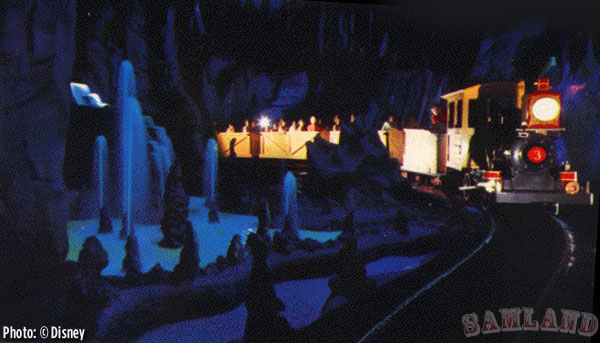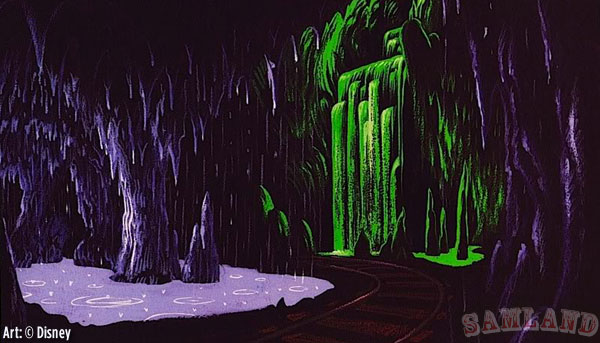1956 was an a year filled with amazing new attractions and the Rainbow Caverns Mine Train promised to be one of the most spectacular. At a reported cost of $500,000, it was also the most expensive addition. The attraction covered seven-acres and was integrated into the space that already featured the Pack Mules, the Stagecoaches, and the Conestoga Wagons. The mine train opened on July 2.
The publicity materials spoke of guests boarding a “cinder-spouting mine train” and journey “through the canyon, around Rainbow Mountain to Rainbow Desert, into beautiful Rainbow Caverns and Fluorescent Waters.” As the trains travels “deep into the heart of the earth” there are “visual spectacles” like the “Underground River” with “flecks of gold” and the “Stalactite and Stalagmite Caverns” featuring “an unforgettable spectacle of multi-colored waterfalls.” All “presented with the world famous ‘Disney touch.” The Rainbow Caverns Mine Train was Disneyland’s first “D” ticket attraction.
Harper Goff worked on the original concept and Bill Martin began serious planning right after the Park opened. Martin did the layout and designed the miniature buildings in Rainbow Ridge for the loading area. He said, “They were a favorite of Lillian Disney and I remember that Walt and Lilly would often walk along the pathways between those little buildings when they stayed at the park overnight.”
The mine trains were part of the “Rainbow Mountain Mining and Exploration Company (R.M.R.R). They were patterned after an early 1900s industrial steam engine but made to look older because of details like the woodburner smokestack and the large box headlamp.Instead of the “cinder-spouting” locomotives promised, these trains used electric motors powered by batteries stored in the tender car. The locomotives were designed by Roger Broggie.
Walt wanted to use live steam locomotives but he was stopped by Orange County officials. They were upset that Walt had three unlicensed steam engines already on the property. Apparently, nobody pulled permits for the two Disneyland Railroad locomotives and the Mark Twain.
The locomotives were painted green with wooden cabs and were eleven feet in length and four feet four inches in width. The four locomotives each pulled six ore cars that were four feet six inches wide and eight feet six inches long. Inside of each ore car were bench seats along the sides with a door and a jump seat. Each ore car could seat up to ten guests. There was a little round speaker so guests could hear the live narration done by either the Engineer in the locomotive or the Brakeman in the rear. The trains ran on 30″ narrow gauge track and traveled 1,700 feet of track in a long figure eight. The ride took seven minutes.
The backdrop for the loading area was the “little mining town” of Rainbow Ridge. The miniature facades used forced perspective to recreate a frontier town with the Last Change Saloon, the El Dorado Hotel, and the Rainbow Ridge Clarion. From the loading area, the train traveled next to the new Rainbow Desert.
The Rainbow Desert was “the most active desert region man has ever traversed.” The most prominent feature was the Natural Arch Bridge. As the trains passed underneath the arch guests frequently saw the Pack Mules crossing overhead. When the mules were within range, the trains were not allowed to blow their whistles in fear that they would scare them.
The Rainbow Desert was filled with sight gags. There were cactus characters including one who wants to “hitch a ride” and seven more that look like the famous Disney dwarfs. There were sandstone buttes with tiny Pueblos on top. At the Devils Paint Pots, the three attractions meet. This layering of attractions was a signature design element of Bill Martin. The trains also passed underneath the treacherous Balancing Rocks.
The next destination was the Rainbow Caverns designed by Claude Coats. He used ultra-violet lights similar to the Fantasyland dark rides along with special effects using water and fountains to create a two-minute “grand finale.”
Walt was always on the lookout for anything that might be useful in his Park. At some point, he learned of new fluorescent dyes that could go in water and he had the company come out to the Studio. He was already thinking about the mine train ride at the time and this idea really captured his imagination. Coats describe
Walt had envisioned a train that would go through a building and the guests would see fluorescent waterfalls. He turned to Claude Coats because of his experience in building the Fantasyland dark rides using black light. Coats said, “I got interested, and did sketches and storyboards. We had to make mock-ups with wood first, just to find out how we could handle this water and make it go into the shapes of a witch or a cauldron, or an angel or whatever character we were trying to do.”

The interior of Rainbow Caverns was pitch black. The only illumination came from carefully hidden black lights reflecting upon the fluorescent materials. The room was filled with different colorful waterfalls and rivers. Claude Coats had come up with many special effects that had never been tried successfully before. For example, when he was working on Rainbow Falls, the grand finale, he wanted “all six primary colors falling side by side in one big wide waterfall.” The water flowed in separate troughs and when it hit the bottom he “wanted to have them as close together as we could, so they were separated by a very few inches.” Coats remembered, “There was a mathematician [Heinz Haber] at the Studio that had come over with Wernher von Braun [the German rocket scientist], and he looked at this waterfall and said that it was statistically impossible.” The expert told him “there would be enough splash between one color and the next, no matter how well we controlled it, that it would be all gray in one week.” When Walt came by Coats said, “Heinz Haber said that it was statistically impossible.” Walt turned to Coats and replied, “Well, it’s fun to do the impossible.” He then left.
Each of the waterfalls had names that reflected their special quality. Staircase Falls was all one color and shaped as it is named. At Bridal Veil Falls, the waterfall seemed to outline a slender figure. Rainbow Falls was spectacular. Others included Angel Falls, Staircase Falls, Paint Pot Falls, Geyser Grotto, Dance of the Seven Sisters, and Witches Cauldron. All of this was accompanied by a haunting soundtrack performed by female choir accompanied by a Theremin.
Original Disneylander Ron Dominguez worked on the attraction in the early days and recalled derailing the train several times. He said, “I’d bring a train on and forget to go back and throw the switch to the main line. The poor guy who would be coming around through the Caverns would come out and his train would derail.” They had to install an upright paddle switch and named it after Dominguez.
The addition of the Mine Train meant changes to the original Frontierland attractions. The loading areas were arranged with the Mine Train and Rainbow Ridge to the east, the renamed Rainbow Ridge Pack Mules was in the middle, and the renamed Rainbow Mountain Stagecoaches and Conestoga Wagons shared the same loading area to the west.
The Rainbow Ridge Pack Mules promised to take riders “past frontier settlements into wilderness.” They would “follow Dinosaur Trail over Natural Bridge to Rainbow Mountain.” The stagecoach and wagons would go “across the valley, under Natural Bridge into Rainbow Desert and return via Indian Territory and Wilderness River with view of Tom Sawyer Island.” This meant there was an interaction between the three different transportation systems that created something greater than the sums of the parts. Since the show elements were primarily pointed toward the Mine Train, a trip on the Pack Mules or the wagons gave a whole different perspective.
In 1960, the Mine Train attraction was enhanced and renamed the Mine Train Through Nature’s Wonderland. But that’s a story for another day.
If you enjoy reading SAMLAND, you’ll love his book. Walt and the Promise of Progress City is a detailed look into how Walt Disney envisioned the future of communities. Along the way, we explore many facets of a fascinating man.








You must be logged in to post a comment.